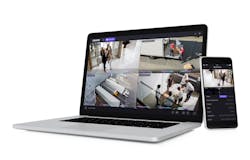Security professionals have been warning about the cyber threats presented by physical systems connected to the internet for nearly as long as IP technology has been around. Of course, these are not just theoretical vulnerabilities but ones that have been leveraged by hackers to carry out various attacks.
For example, the distributed denial of service (DDoS) botnet attack launched against Dyn DNS services in late 2016 that caused major outages for a number of popular websites, including Amazon, Twitter and Netflix, leveraged a large number of IoT devices – predominantly surveillance cameras – infected by a malware strain known as Mirai to flood the affected servers with traffic. In early 2017, two Romanian hackers were able to infect two-thirds of Washington, D.C.’s camera network with malware just days before the inauguration of President Donald Trump.
But while incidents like these have cast a large spotlight on the problems presented by unsecured physical security systems, the two disciplines of physical and cybersecurity have largely remained siloed, especially within the vendor community. However, one company, Ava, is looking to change that by bringing these two sides of the house together to provide end-users with a truly unified security solution.
The company was founded as the result of merger earlier this year between cybersecurity firm Jazz Networks and video security provider Vaion. Ava combines the cyber insider threat detection tools offered by Jazz Networks and combines them with intelligent video analysis solutions from Vaion to help end-users discover patterns or anomalies across their entire security ecosystem in both the physical and cyber domains.
The company is exhibiting for the first time since the merger at GSX+ this week and is announcing the release of its new Ava Aware Cloud video solution in conjunction with the virtual event.
According to Tormod Ree, Ava’s CEO, the company wants to solve what it sees as three “fundamental problems” in security including data overload, complexity of systems and a relative dearth of solutions that leverage both best of breed physical and cybersecurity technologies. As it pertains to data and sifting through the vast amounts of video that organizations are generating today, Ava’s machine learning platform can be applied to help organizations become more proactive in their security programs.
“We analyze video from all of the cameras (in an organization) in real-time with machine learning-based artificial intelligence. That can be done with our cameras or with third-party cameras and we do this at scale cost-effectively,” Ree explains. “We then deploy video intelligence on objects such as vehicles or people, and look at their characteristics such as color in the case of a vehicle or gender when you look at people. We also look for events and use machine learning to determine what is normal or abnormal. And we provide the combination of an on-prem and secure cloud solution in what you could call a hybrid-cloud architecture.”
With Ava Aware Cloud, however, Ree notes that end-users will now be able to deploy the company’s AI platform as a native cloud solution. Since there is no on-premises infrastructure, cameras can be plugged in and automatically configured, thereby reducing complexity and installation times to mere minutes.
“An organization of any size can reap the benefits of their existing (video) solution… and to get up and running, all you have to do is get a camera, plug it into the internet and it will obviously be accessible from anywhere as well as up to date and secure,” he adds.
The combination of the company’s cybersecurity solution with its analytic capabilities also enables Ava to protect end-users from risks originating from within their own organizations, even those posed by the COVID-19 pandemic.
“Our data analytics and video security platform also provide insider threat risk assessments for COVID-type risk cases,” Ree explains. “There are a few things we’re seeing the solution used for now more than before and one is with social distancing or spacing people out and we do that with our people-counting solution. That is one important use case, the other is using our search capabilities for contact tracing to be able to quickly identify a person’s movement in area or building.”
To learn more about Ava or its new Aware Cloud solution, check out the GSX+ Marketplace during the online conference taking place Sept. 21-25 .
Joel Griffin is the Editor-in-Chief of SecurityInfoWatch.com and a veteran security journalist. You can reach him at [email protected].


